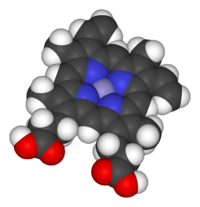
Photo from wikipedia
Ticks are blood-feeding ectoparasites with distinct genomic reductions, inevitably linking them to a parasitic life-style. Ticks have lost the genomic coding and, thus, biochemical capacity to synthesize heme, an essential… Click to show full abstract
Ticks are blood-feeding ectoparasites with distinct genomic reductions, inevitably linking them to a parasitic life-style. Ticks have lost the genomic coding and, thus, biochemical capacity to synthesize heme, an essential metabolic cofactor, de novo. Instead, they are equipped with acquisition and distribution pathways for re-use of host heme. Unlike insects or mammals, ticks and mites cannot cleave the porphyrin ring of heme to release iron. Bioavailable of iron is thus acquired by ticks from the host serum transferrin. Somatic trafficking of iron, however, is independent of heme and is mediated by a secretory type of ferritin. Heme and iron systemic homeostasis in ticks represents, therefore, key adaptive traits enabling successful feeding and reproduction.
Journal Title: Current opinion in insect science
Year Published: 2022
Link to full text (if available)
Share on Social Media: Sign Up to like & get
recommendations!